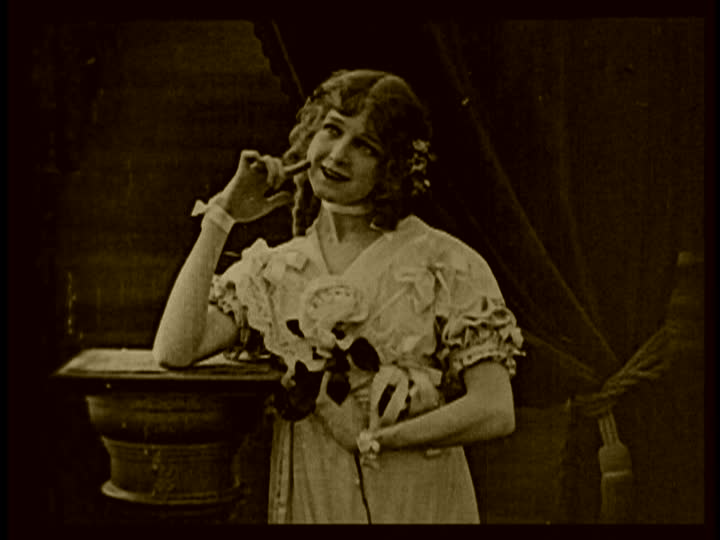In ye olde merrie Englande (that mystical place of superfluous letters), a wastrel of a college student pulls one prank too many and is kicked out of both school and home. He ends up falling for the local parson’s daughter, who makes it her mission to reconcile father and son. Oh, and she thinks she has a magic wishing ring. What? Doesn’t everyone?
Which wish is which?
Before starting, I have a confession. The whole Maurice Tourneur thing… I don’t get it. His movies are gorgeous, yes. Some of the most beautiful of the entire silent era. Any era, in fact. But they are also as slow as molasses on a winter day and they bore me to death. If you can get through Lorna Doone or Pride of the Clan without a stiff drink, you are made of sterner stuff than I ever will be. Even Alias Jimmy Valentine drags for me– and that movie is about safe-cracking and criminals and was filmed in Sing Sing!

Second confession. I only ended up viewing and reviewing this film because I forgot to grab a copy of the other movie I planned to cover. Oh, I was thrilled to be seeing this. Just couldn’t wait to get it playing. (Sarcasm.)
My point is that this film probably had the most hostile audience it would ever get among silent movie fans. So, will it come as a shock if I say that I liked this movie? A lot, actually.
But I am getting ahead of myself. First, let’s talk a bit about the plot.

Giles (Chester Barnett) is a hard-partying college boy. One fine evening, he parties a little too hard and finds himself expelled from school. This does not sit well with his father, the Earl of Bateson (Alec B. Francis), and he throws his son out of the house. Later, the earl writes his conditions for reconciliation: Giles can never return until he is able to earn half a crown without anyone’s help.
Giles makes his way to the home of a family friend. As it turns out, the gardener has been discharged over a large number of stolen roses. Giles is an amateur gardener and promises to tend to the bushes.

But who is stealing the roses? As it turns out, the thief is Sally (Vivian Martin), the local parson’s daughter. Giles catches her red-handed but he softens when she shows him that she only took the roses to decorate the church altar. The pair bond over bread and jam. All the while, Sally thinks Giles is a simple gardener. He doesn’t correct her because he is afraid of scaring her away.
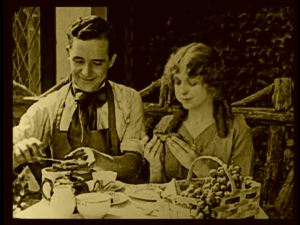
For the first time in his life, Giles is acting like a responsible adult who actually does nice things for others. He shares his lunch with Sally, comes calling at her house and even drinks her strange herbals teas. One evening, they visit a gypsy camp and the naïve Sally buys a ring that is supposed to grant wishes. Giles sees it as an opportunity to give Sally presents without blowing his cover and soon lovely dresses and shoes are appearing with cards signed by the Wishing Ring.

Of course, Sally is not stupid and soon figures out who Giles really is. She becomes determined to reconcile father and son.
This movie is the most beautiful and sophisticated production from 1914 that I have seen to date. Tourneur’s compositions and lighting are intoxicating. Here is a sample of my favorites:
Beauty would mean nothing, though, if the characters and performances were not up to snuff. One thing I really enjoyed about The Wishing Ring was the sheer number of flaws that the characters possess. Giles could easily have been noble, Sally could have been just a sweet girl and we would have been left with a far less interesting story.

The film is populated by eccentric and interesting people.
Instead, Giles has an honest-to-goodness character arc. He starts out as a rather unpleasant fellow. The frat boy you do not want living next door to you. He is rude, wild and he kicks dogs. Cute little fluffy ones. He is inspired by Sally’s generous spirit and begins to make amends. (Including befriending cute little fluffy dogs.)
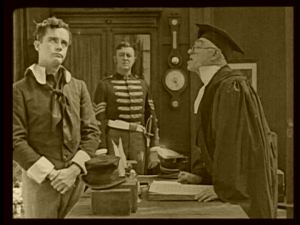
Sally, meanwhile, is a caring and generous soul but her optimistic spirit has a way of backfiring. She sings loudly but poorly. She pours a bilious herbal concoction in place of tea and isn’t sure why no one asks for seconds. She gets an innocent gardener fired because she doesn’t realize that rosebushes on a private estate are not communal. And, randomly, she is something of a chess wiz.

All this adds up to a well-rounded character who charms both the audience and Giles. Keep in mind, this was the height of the bird-smooching heroines. (If you are unfamiliar with the idea of a heroine constantly kissing a bird, just watch a few more movies from the ‘teens. Good heavens, they’re everywhere!) Sally fits into the sweetheart ideal but is also interesting and funny.

In one particularly cute scene, Giles shares his bread and jam with Sally, who scarfs it down hamster-style. Giles absentmindedly picks up a bunch of grapes and starts eating them as he walks. Sally eyes the grapes, follows Giles, starts to steal a grape here and a grape there and finally purloins the whole bunch. It’s a well-performed bit of physical comedy and it’s cute without being cutesy.
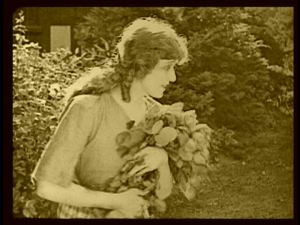
Vivian Martin really steals the show as Sally. Her sly performance is a delight. Unfortunately, information on Martin is rare and her films are rarer still. According to her IMDB profile (which we all know must be taken with a mine’s worth of salt) she tried to set up her own production company in the early twenties but the films were unsuccessful. She has two credits for 1921, one for 1925 and one for 1935, none after.

Cliff over at Immortal Ephemera found a “where are they now?” article from 1936, which states that Martin returned to the stage. She married editor Arthur H. Samuels (formerly of the New Yorker and Harper’s Bazaar) and the wedding announcement confirms that she had a number of stage roles. According to IMDB, she retired from the stage and enjoyed a comfortable life of philanthropy. I hope it’s true, given the number of early stars who spent their final years in poverty. It would be nice to think that this charming and talented actress had a happy ending.
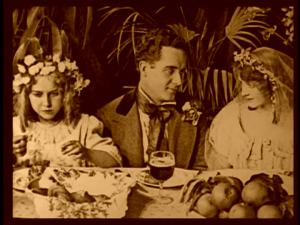
As for the rest of the cast, comedy fans will be able to spot Johnny Hines in a small supporting role. Chester Barnett is also enjoyable to watch. His humorous face and rubbery features reminded me of Rowan Atkinson.
Maurice Tourneur’s impeccable taste in composition, lighting and setting all make The Wishing Ring a visual feast that could easily have been made a decade later. And, in this case, the nimble script and whimsical story create a fast-moving story that never drags for a second.

Want to hear some scary news? It was almost lost. There were no known copies of the film until historian Kevin Brownlow tracked down a 16mm print being held by a private collector in England.
Whew! Excellent save, Mr. Brownlow. I am astonished at the sophistication of the production’s technical side and charmed by the simple story and charismatic cast. The Wishing Ring is enchanting. I dare you to finish it without a smile on your face.
Movies Silently’s Score: ★★★★½
Where can I see it?
The Wishing Ring was released as an extra of the DVD of the documentary Before Hollywood, There Was Fort Lee, N.J. It has a score from the Mont Alto Motion Picture Orchestra. There is also a version released by Reel Classic DVD
but I have not viewed it.
